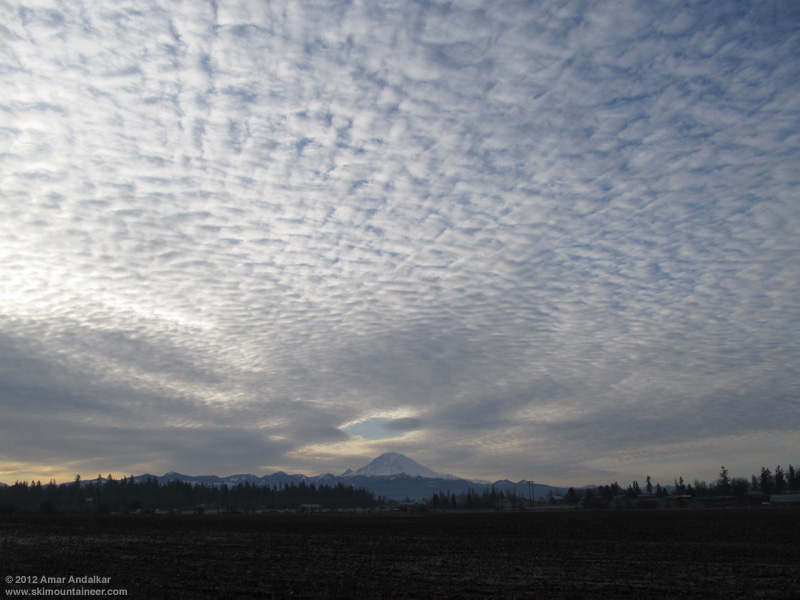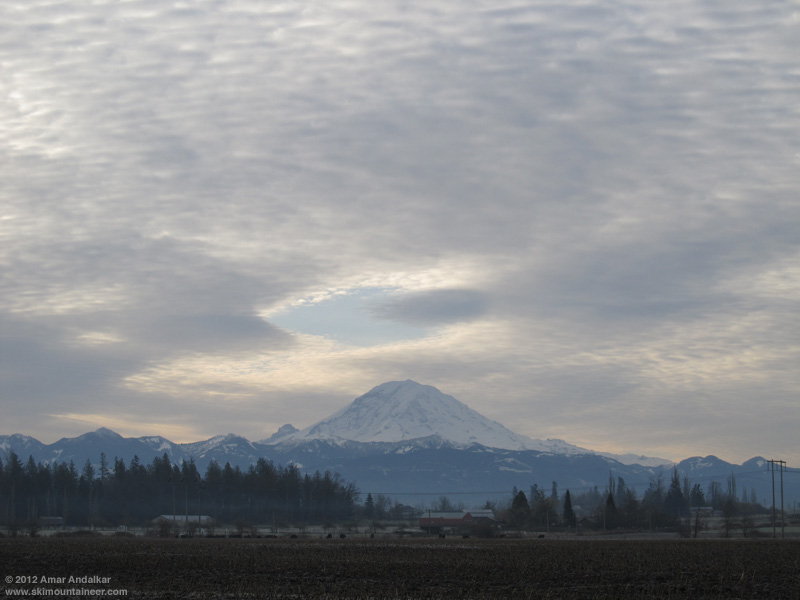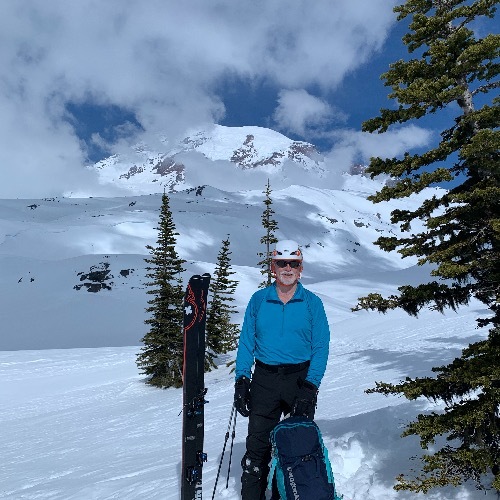- Posts: 635
- Thank you received: 0
Unusual lenticular "hole" cloud above Mt Rainier
- Amar Andalkar
- [andalkar]
-
 Topic Author
Topic Author
- Offline
- Premium Member
-

Less
More
08 Mar 2012 18:39 #204421
by Amar Andalkar
Unusual lenticular "hole" cloud above Mt Rainier was created by Amar Andalkar
Lenticular clouds (Altocumulus lenticularis) are among the most beautiful and photogenic of all types of clouds. Large isolated mountains such as stratovolcanoes tend to form lenticular clouds quite often, with lenticulars visible above Mount Rainier and other Cascade volcanoes on at least a few dozen days each year.
I've seen and photographed countless lenticulars over many of the Cascade volcanoes plus several other peaks, and also looked at countless photos in books and online of lenticulars on mountains around the world. But I don't recall ever seeing what I saw today: a lenticular-shaped hole in an altocumulus cloud deck above Mount Rainier. Almost an anti-lenticular cloud of sorts:

[size=small](click for double-size version)[/size]

[size=small](click for double-size version)[/size]
These photos were taken at 7:40am on March 8, 2012, looking SE from a farm just off SR 164, a couple miles NW of Enumclaw and 30 miles NW of the summit of Mount Rainier.
So what caused this very unusual cloud formation? My best guess is that this is an example of a fallstreak hole , which is a hole in an altocumulus cloud deck caused by some type of localized disturbance which results in the freezing (and precipitating out) of the supercooled water droplets present in the altocumulus cloud layer -- thus forming a hole in the cloud layer at the site of the disturbance. Such a disturbance which forms a fallstreak hole is nowadays most commonly caused by a jetliner ascending or descending through the altocumulus cloud deck. But in this case, the uplift of air flowing at lower levels (below the altocumulus layer) past Mount Rainier is the apparent and obvious cause of this hole. The right side of the hole appears to also have a small normal lenticular cloud partially filling it.
If anyone out there has photos of a similar lenticular hole cloud formation over Rainier or any other mountain, I would certainly like to see them.
This cloud formation (including the hole) had been visible for at least 10-15 minutes by the time I stopped the car and took the photos. But the altocumulus cloud layer (along with the hole) soon faded, and it had vanished almost entirely by the time I arrived at the top of the Crystal Mountain gondola just over an hour later at 8:55am (the gondola began loading the public by 8:40am today):
Several very different cloud types are seen in this photo: high wispy cirrus clouds far above, two small patches of lingering altocumulus at mid levels (center of photo, above Rainier), and several large elongated lee wave clouds at left (these are another variant of Altocumulus lenticularis).
The lee wave clouds would continue to grow in size during the day as SW winds increased aloft and atop Crystal too, becoming quite strong and gusty by 11am, resulting in gondola slowdowns but causing no issues on the Rainier Express lift. By 1pm, the lee wave clouds had grown enough to almost completely obscure the sun from Crystal's ski slopes, resulting in a premature firming and refreezing of the snow which had been nicely softened on all sunny aspects. Areas to the north of Crystal still remained sunlit though, outside the shadow of the lee wave clouds, and the drive back north along SR 410 was entirely sunny.
The large mass of lee wave clouds can still be seen extending left (NE) from Rainier in this photo taken just before 3pm, from the same location near Enumclaw as the first two photos:
I've seen and photographed countless lenticulars over many of the Cascade volcanoes plus several other peaks, and also looked at countless photos in books and online of lenticulars on mountains around the world. But I don't recall ever seeing what I saw today: a lenticular-shaped hole in an altocumulus cloud deck above Mount Rainier. Almost an anti-lenticular cloud of sorts:

[size=small](click for double-size version)[/size]

[size=small](click for double-size version)[/size]
These photos were taken at 7:40am on March 8, 2012, looking SE from a farm just off SR 164, a couple miles NW of Enumclaw and 30 miles NW of the summit of Mount Rainier.
So what caused this very unusual cloud formation? My best guess is that this is an example of a fallstreak hole , which is a hole in an altocumulus cloud deck caused by some type of localized disturbance which results in the freezing (and precipitating out) of the supercooled water droplets present in the altocumulus cloud layer -- thus forming a hole in the cloud layer at the site of the disturbance. Such a disturbance which forms a fallstreak hole is nowadays most commonly caused by a jetliner ascending or descending through the altocumulus cloud deck. But in this case, the uplift of air flowing at lower levels (below the altocumulus layer) past Mount Rainier is the apparent and obvious cause of this hole. The right side of the hole appears to also have a small normal lenticular cloud partially filling it.
If anyone out there has photos of a similar lenticular hole cloud formation over Rainier or any other mountain, I would certainly like to see them.
This cloud formation (including the hole) had been visible for at least 10-15 minutes by the time I stopped the car and took the photos. But the altocumulus cloud layer (along with the hole) soon faded, and it had vanished almost entirely by the time I arrived at the top of the Crystal Mountain gondola just over an hour later at 8:55am (the gondola began loading the public by 8:40am today):
Several very different cloud types are seen in this photo: high wispy cirrus clouds far above, two small patches of lingering altocumulus at mid levels (center of photo, above Rainier), and several large elongated lee wave clouds at left (these are another variant of Altocumulus lenticularis).
The lee wave clouds would continue to grow in size during the day as SW winds increased aloft and atop Crystal too, becoming quite strong and gusty by 11am, resulting in gondola slowdowns but causing no issues on the Rainier Express lift. By 1pm, the lee wave clouds had grown enough to almost completely obscure the sun from Crystal's ski slopes, resulting in a premature firming and refreezing of the snow which had been nicely softened on all sunny aspects. Areas to the north of Crystal still remained sunlit though, outside the shadow of the lee wave clouds, and the drive back north along SR 410 was entirely sunny.
The large mass of lee wave clouds can still be seen extending left (NE) from Rainier in this photo taken just before 3pm, from the same location near Enumclaw as the first two photos:
Please Log in or Create an account to join the conversation.
- Andrew Carey
- [acarey]
-

- Offline
- Elite Member
-

Less
More
- Posts: 912
- Thank you received: 0
09 Mar 2012 06:33 #204432
by Andrew Carey
Replied by Andrew Carey on topic Re: Unusual lenticular "hole" cloud above Mt Rainier
very, very nice observation and photos, Amar; in 30 years of hanging around western WA, I haven't seen that. Thanks.
Please Log in or Create an account to join the conversation.
- E_N
- [E_N]
-

- Offline
- New Member
-

Less
More
- Posts: 27
- Thank you received: 0
09 Mar 2012 09:27 #204435
by E_N
Replied by E_N on topic Re: Unusual lenticular "hole" cloud above Mt Rainier
Great picture Amar. I don't think I've ever seen anything quite like that.
Coincidentally, Cliff Mass was talking about lenticulars on his blog yesterday as well. It's a very breif post, but it has a cool schematic of where the pressure waves created by the mountain are likely to form clouds.
cliffmass.blogspot.com/2012/03/lenticular-clouds.html
Coincidentally, Cliff Mass was talking about lenticulars on his blog yesterday as well. It's a very breif post, but it has a cool schematic of where the pressure waves created by the mountain are likely to form clouds.
cliffmass.blogspot.com/2012/03/lenticular-clouds.html
Please Log in or Create an account to join the conversation.
- Jake the Brit
- [Jake the Brit]
-

- Offline
- Junior Member
-

Less
More
- Posts: 70
- Thank you received: 0
12 Mar 2012 19:45 #204493
by Jake the Brit
Replied by Jake the Brit on topic Re: Unusual lenticular "hole" cloud above Mt Rainier
Seems to me you had it right 1st time, it's an anti-lenticular cloud:
If the air above the cloud base were temperature-inverted, ie warmer, then the wave motion which normally forces the air up to form lenticulars by cooling, has effectively evaporated (wrong word I'm sure) the cloud by forcing it up into the warmer air aloft, making the hole approximately where the lenticular woul dhave been if it were cold aloft.
If you look downstream, left, you can see the cloud layer is thinner, perhaps indicating the same effect downstream.
OK, I'm ready, let me have it!
If the air above the cloud base were temperature-inverted, ie warmer, then the wave motion which normally forces the air up to form lenticulars by cooling, has effectively evaporated (wrong word I'm sure) the cloud by forcing it up into the warmer air aloft, making the hole approximately where the lenticular woul dhave been if it were cold aloft.
If you look downstream, left, you can see the cloud layer is thinner, perhaps indicating the same effect downstream.
OK, I'm ready, let me have it!
Please Log in or Create an account to join the conversation.
- Amar Andalkar
- [andalkar]
-
 Topic Author
Topic Author
- Offline
- Premium Member
-

Less
More
- Posts: 635
- Thank you received: 0
20 Mar 2015 19:03 #224247
by Amar Andalkar
Replied by Amar Andalkar on topic Re: Unusual lenticular "hole" cloud above Mt Rainier
Out of the blue today, one of my friends sent me the photo below, looking at Mount Baker from the Sulphide Glacier on Mount Shuksan in January 2014, and asking if I had ever seen something like it before -- I certainly had! The photo appears to show the same phenomenon as my 2012 images from Rainier above, with rising air deflected upward by Baker punching a hole in an overhead deck of altocumulus or altostratus clouds (the clouds in the distance are definitely altostratus, while those directly above Baker fall somewhere on the continuum between those 2 cloud types):
[size=small](Photo by David Coleman)[/size]
In this case it's much more definitely a fallstreak hole , due to the characteristic wispy condensed cloudlets within the hole. Other than my own, this is the only other image I've ever seen of a fallstreak hole caused by airflow rising over an isolated stratovolcano or any other mountain.
If anyone out there has photos of a similar hole cloud formation over any mountain, I would still definitely like to see them.
[size=small](Photo by David Coleman)[/size]
In this case it's much more definitely a fallstreak hole , due to the characteristic wispy condensed cloudlets within the hole. Other than my own, this is the only other image I've ever seen of a fallstreak hole caused by airflow rising over an isolated stratovolcano or any other mountain.
If anyone out there has photos of a similar hole cloud formation over any mountain, I would still definitely like to see them.
Please Log in or Create an account to join the conversation.



